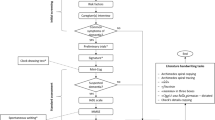Abstract
Handwriting examinations are commonly performed in the analysis of tremor and Parkinson’s disease (PD). We analyzed the accuracy of subjective and objective assessment of handwriting samples for distinguishing 27 PD cases, 22 with tremulous PD, and five with akinetic-rigid PD, from 39 movement-disorder patients with normal presynaptic dopamine imaging (subjects without evidence of dopamine deficiency or SWEDDs; 31 with dystonic tremor (DT), six indeterminate tremor syndrome, one essential tremor, one vascular parkinsonism). All handwriting analysis was performed blind to clinical details. Subjective classification was made as: (1) micrographia, (2) normal, or (3) macrographia. In addition, a range of objective metrices were measured on standardized handwriting specimens. Subjective assessments found micrographia more frequently in PD than SWEDDs (p = 0.0352) and in akinetic-rigid than tremulous PD (p = 0.0259). Macrographia was predominantly seen in patients with dystonic tremor and not other diagnoses (p = 0.007). Micrographia had a mean sensitivity of 55 % and specificity of 84 % for distinguishing PD from SWEDDs and mean sensitivity of 90 % and specificity of 55 % for distinguishing akinetic-rigid PD from tremulous PD. Macrographia had a sensitivity of 26 % and specificity of 96 % for distinguishing DT from all other diagnoses. The best of the objective metrices increased sensitivity for the distinction of SWEDDs from PD with a reduction in specificity. We conclude that micrographia is more indicative of PD than SWEDDs and more characteristic of akinetic-rigid than tremulous PD. In addition, macrographia strongly suggests a diagnosis of dystonic tremor.

Similar content being viewed by others
References
Marek K, Jennings D, Seibyl J (2003) Imaging the dopamine system to assess disease-modifying drugs: studies comparing dopamine agonists and levodopa. Neurology 61(6 Suppl 3):S43–S48
Whone AL, Watts RL, Stoessl AJ, Poewe WH, Hauser RA et al (2003) REAL-PET Study Group. Slower progression of Parkinson’s disease with ropinirole versus levodopa: The REAL-PET study. Ann Neurol 54:93–101
Parkinson Study Group (2000) Pramipexole vs levodopa as initial treatment for Parkinson disease: a randomized controlled trial. JAMA 284:1931–1938
Fahn S (2005) Does levodopa slow or hasten the rate of progression of Parkinson’s disease? J Neurol 252(Suppl 4):VI37–VI42
Marek K, Jennings D, Seibyl J (2005) Long-term follow-up of patients with scans without evidence of dopaminergic deficit (SWEDD) in the ELLDOPA study. Neurology 64:A274 Abstract
Marshall VL, Patterson J, Hadley DM, Grosset KA, Grosset DG (2006) Successful antiparkinsonian medication withdrawal in patients with parkinsonism and normal FP-CIT SPECT. Mov Disord 21:2247–2250
Silveira-Moriyama L, Schwingenschuh P, O’Donnell A et al (2009) Olfaction in patients with suspected parkinsonism and scans without evidence of dopaminergic deficit (SWEDDs). J Neurol Neurosurg Psychiatry 80(7):744–748
Soane T, Grosset D, Lees A, Bajaj N (2009) Scans without evidence of dopaminergic deficit: diagnosis, etiology, and management. Curr Med Lit 25(4):93–103
Schneider SA, Edwards MJ, Mir P et al (2007) Patients with adult-onset dystonic tremor resembling parkinsonian tremor have scans without evidence of dopaminergic deficit (SWEDDs). Mov Disord 22:2210–2215
Bain PG (2009) Dystonic tremor presenting as Parkinsonism—long-term follow-up of a SWEDDS patient. Neurology 72(16):1443–1445
McLennan JE, Nakano K, Tyler HR, Schwab RS (1972) Micrographia in Parkinson’s disease. J Neurol Sci 15(2):141–152
Stewart DA (2007) NICE guideline for Parkinson’s disease. Age Ageing 36:240–242
Bajaj NP, Gontu V, Birchall J, Patterson J, Grosset DG, Lees AJ (2010) Accuracy of clinical diagnosis in tremulous parkinsonian patients: a blinded video study. J Neurol Neurosurg Psychiatry 81(11):1223–1228
Bajaj NP, Knöbel M, Gontu V, Bain PG (2011) Can spiral analysis predict the FP-CIT SPECT scan result in tremulous patients? Mov Disord 26(4):699–704. doi:10.1002/mds.23507
Phillips JG, Bradshaw JL, Chiu E, Bradshaw JA (1994) Characteristics of handwriting of patients with Huntington’s disease. Mov Disord 9(5):521–530
Beversdorf DQ, Anderson JM, Manning SE, Anderson SL, Nordgren RE, Felopulos GJ, Bauman ML (2001) Brief report: macrographia in high-functioning adults with autism spectrum disorder. J Autism Dev Disord 31(1):97–101
Louis ED, Faust PH, Vonsattel J-P et al (2007) Neuropathological changes in essential tremor: 33 cases compared with 21 controls. Brain 130(12):3297–3307
Tucha O, Mecklinger L, Thome J et al (2006) Kinematic analysis of dopaminergic effects on skilled handwriting movements in Parkinson’s disease. J Neural Transm 113(5):609–623
Conflicts of interest
DG has received consultancy fees from Civitas Therapeutics Inc, Vectura Group plc, and honoraria from Teva/Lundbeck, UCB Pharma, GSK, Pharmacia, and Abbott. Nin Bajaj—Stock Ownership in medically-related fields: none; Consultancies: none; Advisory Boards: UCB Pharma, GE Healthcare; Partnerships: none; Honoraria: UCB, Teva, GE Healthcare, Genus; Grants: MRC, Parkinson’s UK; Intellectual Property Rights: none; Expert Testimony: none; Employment: NHS; Contracts: none; Royalties: none. P.G. Bain: none.
Author information
Authors and Affiliations
Corresponding author
Rights and permissions
About this article
Cite this article
Bajaj, N.P.S., Wang, L., Gontu, V. et al. Accuracy of subjective and objective handwriting assessment for differentiating Parkinson’s disease from tremulous subjects without evidence of dopaminergic deficits (SWEDDs): an FP-CIT-validated study. J Neurol 259, 2335–2340 (2012). https://doi.org/10.1007/s00415-012-6495-5
Received:
Revised:
Accepted:
Published:
Issue Date:
DOI: https://doi.org/10.1007/s00415-012-6495-5




